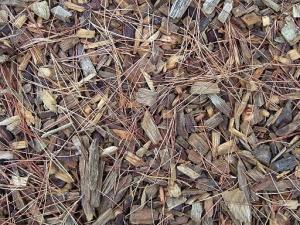Mulch
Revision as of 19:35, 15 January 2019 by Kyle menken (talk | contribs)
The printable version is no longer supported and may have rendering errors. Please update your browser bookmarks and please use the default browser print function instead.
- Mulch should be applied on the surface of the BMP in a layer of 75 -100 mm.
- As in other landscaping applications, the mulch helps to preserve soil moisture for plant survival, and suppresses weed growth.
- Mulch is considered to be an normal finishing touch to many types of formal landscaping. Maintaining mulch application can help increase aesthetic value of LID BMPs.
- Regular fresh applications of wood mulch can also promote denitrification, reducing nitrates in impacted surface waters.
- Shredded hardwood mulch or pine mulch is generally recommended for LID facilities. Its fibrous texture knits together somewhat; providing limited erosion control.
- Mulch can also help to maintain the organic matter content of filter media, which provides cation exchange capacity for pollutant removal.
Contraindication[edit]
- In areas with particularly high flow (e.g. around inlets and forebays) coarse decorative aggregate or stone is recommended instead, as these will not float. All organic mulches have the potential to float and migrate in surface flow, particularly after a previously dry period. [1]
- This advice also holds for stormwater planters, which often experience concentrated flow from a downspout disconnection or similar.
- ↑ Simcock, R and Dando, J. 2013. Mulch specification for stormwater bioretention devices. Prepared by Landcare Research New Zealand Ltd for Auckland Council. Auckland Council technical report, TR2013/056
